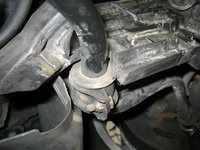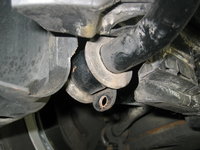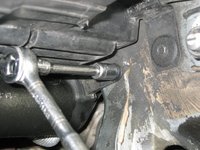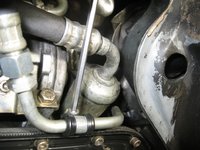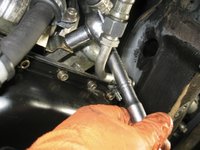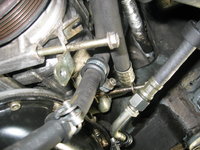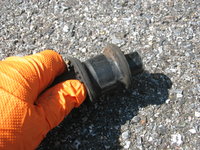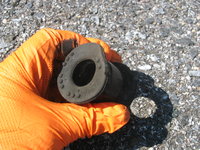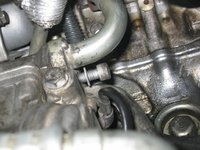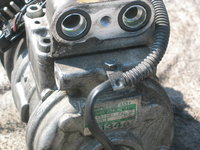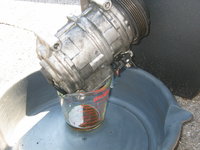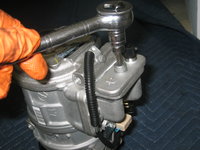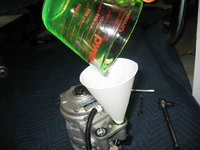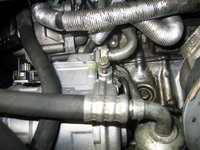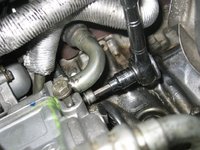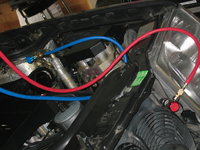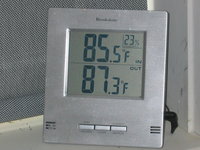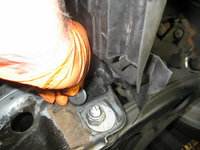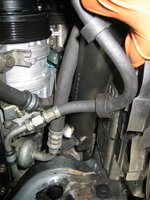This HOW-TO is focused on replacing the A/C compressor in the V-8-based W124 Mercedes-Benz models. Since the compressor and key components of the A/C system are very similar on other W124 models, most of this HOW-TO should also apply to the inline-six models.
The Nippon Denso compressor as used in the W124 MB models is generally very reliable. However, "accessory" items such as the electromagnetic clutch on the front of the compressor, and the RPM sensor on the rear, do tend to go out with age, mileage and usage. The clutch is considered a "wear" item, and with use will wear down and eventually have difficulty engaging when the signal is sent by the climate control system to do so. Often this will show up as codes from the BM (Base Module) computer that indicate clutch non-engagement and/or belt slippage. RPM sensor failure or intermittent engagement can also show a "belt slippage" code, because the engine's RPM is being sensed by the BM as not being in sync with the compressor RPM due to failure of the sensor.
Both the RPM sensor and the clutch can be removed from the compressor and replaced; however, only the clutch assembly is available from MB as a separate component. The price on the clutch is somewhere around $150; you can purchase a brand-new Denso compressor via Amazon or other online sources for not much over $200, and via many other sources for $250-275, which is a more typical price. If you want to replace the RPM sensor, you would have to find a used one from another compressor; it is (again) just easier to remove and replace the entire compressor, which has NEW clutch and RPM sensor attached.
Note that if you wanted to remove the clutch or RPM sensor to replace them, it is pretty much de rigeur to remove the compressor to do so, so that you have everything exposed on the workbench. And again, since you would have to remove the compressor, doing all the work, it's just easier to remove and replace the entire compressor assembly and get new components with it.
R&R of the compressor assembly is roughly about a Level 5 job, on a 1-10 difficulty scale.
Tools reqiured:
Fluids required:
It is important, before you open the A/C system or remove any components, that you properly evacuate the A/C system of refrigerant. This is best done by a professional shop that has an R134a refrigerant evacuation machine. Have the shop evacuate the system with their machine, and in the process they can pull a vacuum on the system. Pulling a vacuum will tell you whether you have any leaks in the system (before you get started), which is helpful information to know. Generally it takes about 45-60 minutes for a shop to evacuate the system, and would generally cost $75-125 to have them do this. This is more responsible than just venting the refrigerant into the atmosphere, which in the past has been illegal.
Getting to the job:
The first step, after evacuating all refrigerant from the A/C system, is to get the car positioned properly. You will need to pull the car up on ramps, or put it on a lift if you have one. Ramps (or jack stands) are just fine; they should provide plenty of clearance under the car, and the compressor is located on the bottom side of the engine on the driver's side. So, it is relatively easy to access for this job.
In this case, I used ramps for the job. Pull the car up on the ramps, apply the parking brake, and secure one of the back wheels with a pair of wheel chocks. This will keep it stable and secure for the work you are going to do.


The next step is to open the hood. Put it in the vertical position for best access to everything, if you have the overhead space to raise it.


After that, get underneath the car, and use your 8mm socket and ratchet/extension to remove the eight screws that hold the plastic underbelly panel to the bottom of the engine compartment. Note that my panel, after driving the car nearly 2,500 miles after last year's Top End Refresh, has ZERO oil drops or other oily gunk on the belly pan..just a little bit of dirt/dust that blew in, but this is of no concern. This made me very happy to see!


The next step is to disconnect the battery. Loosen and remove the negative battery terminal from the battery, using your 13mm box-end wrench. I wrap the negative terminal in a dry rag, and set it aside next to the battery so that it doesn't make contact with anything.


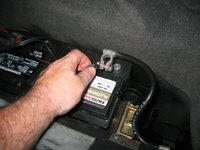
Next up, remove the driver's side "zoom tube" from the intake air-box and the headlight airflow scoop.

Unplug the intake air temperature sensor from the headlight airflow scoop and set it aside. Then pull up on the scoop to remove it from the car.

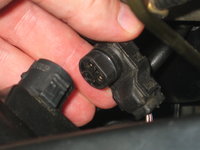

Next up, loosen the belt tensioner to free the belt. Later E500E owners with the revised belt tensioner design have it somewhat easier here. If you have the later tensioner design, you'll need your E-10 female/internal Torx socket to do this properly.
Rotate the belt tensioner toward the passenger side of the engine compartment to loosen the slack on the belt. This should free up enough slack so that you can slip the belt off of the tandem pump pulley, and other pulleys in the engine compartment as shown. Slip the serpentine belt off of the A/C compressor pulley, located underneath the tandem pump pulley. You should be able to do this from above with no problem.



More to come as the job progresses. This post will be updated with additional tools and other equipment on an ongoing basis.
The Nippon Denso compressor as used in the W124 MB models is generally very reliable. However, "accessory" items such as the electromagnetic clutch on the front of the compressor, and the RPM sensor on the rear, do tend to go out with age, mileage and usage. The clutch is considered a "wear" item, and with use will wear down and eventually have difficulty engaging when the signal is sent by the climate control system to do so. Often this will show up as codes from the BM (Base Module) computer that indicate clutch non-engagement and/or belt slippage. RPM sensor failure or intermittent engagement can also show a "belt slippage" code, because the engine's RPM is being sensed by the BM as not being in sync with the compressor RPM due to failure of the sensor.
Both the RPM sensor and the clutch can be removed from the compressor and replaced; however, only the clutch assembly is available from MB as a separate component. The price on the clutch is somewhere around $150; you can purchase a brand-new Denso compressor via Amazon or other online sources for not much over $200, and via many other sources for $250-275, which is a more typical price. If you want to replace the RPM sensor, you would have to find a used one from another compressor; it is (again) just easier to remove and replace the entire compressor, which has NEW clutch and RPM sensor attached.
Note that if you wanted to remove the clutch or RPM sensor to replace them, it is pretty much de rigeur to remove the compressor to do so, so that you have everything exposed on the workbench. And again, since you would have to remove the compressor, doing all the work, it's just easier to remove and replace the entire compressor assembly and get new components with it.
R&R of the compressor assembly is roughly about a Level 5 job, on a 1-10 difficulty scale.
Tools reqiured:
- Pair of ramps and/or lift
- Pair of wheel chocks, if using ramps
- 8mm socket and appropriate 1/4" ratchet (an extension is optional)
- 3/8" ratchet
- E10 "female" (internal) Torx socket (for belt tensioner on later E500E models)
- Set of A/C gauges
- R-134a refrigerant can tap
- A/C vacuum pump
- Set of A/C o-rings
- 13mm wrench
- 13mm offset box-end wrench (if available)
- 8mm, 10mm and 13mm sockets (1/4" and 3/8" ratchets)
- 5mm Allen key
- 6mm Allen key or Allen socket
- short and long 3/8" socket extensions
- Two measuring cups (from kitchen)
- more
- more
Fluids required:
- 8 oz of PAG-46 refrigerant oil
- Three 12-oz cans of R-134a refrigerant
It is important, before you open the A/C system or remove any components, that you properly evacuate the A/C system of refrigerant. This is best done by a professional shop that has an R134a refrigerant evacuation machine. Have the shop evacuate the system with their machine, and in the process they can pull a vacuum on the system. Pulling a vacuum will tell you whether you have any leaks in the system (before you get started), which is helpful information to know. Generally it takes about 45-60 minutes for a shop to evacuate the system, and would generally cost $75-125 to have them do this. This is more responsible than just venting the refrigerant into the atmosphere, which in the past has been illegal.
Getting to the job:
The first step, after evacuating all refrigerant from the A/C system, is to get the car positioned properly. You will need to pull the car up on ramps, or put it on a lift if you have one. Ramps (or jack stands) are just fine; they should provide plenty of clearance under the car, and the compressor is located on the bottom side of the engine on the driver's side. So, it is relatively easy to access for this job.
In this case, I used ramps for the job. Pull the car up on the ramps, apply the parking brake, and secure one of the back wheels with a pair of wheel chocks. This will keep it stable and secure for the work you are going to do.


The next step is to open the hood. Put it in the vertical position for best access to everything, if you have the overhead space to raise it.


After that, get underneath the car, and use your 8mm socket and ratchet/extension to remove the eight screws that hold the plastic underbelly panel to the bottom of the engine compartment. Note that my panel, after driving the car nearly 2,500 miles after last year's Top End Refresh, has ZERO oil drops or other oily gunk on the belly pan..just a little bit of dirt/dust that blew in, but this is of no concern. This made me very happy to see!


The next step is to disconnect the battery. Loosen and remove the negative battery terminal from the battery, using your 13mm box-end wrench. I wrap the negative terminal in a dry rag, and set it aside next to the battery so that it doesn't make contact with anything.



Next up, remove the driver's side "zoom tube" from the intake air-box and the headlight airflow scoop.

Unplug the intake air temperature sensor from the headlight airflow scoop and set it aside. Then pull up on the scoop to remove it from the car.



Next up, loosen the belt tensioner to free the belt. Later E500E owners with the revised belt tensioner design have it somewhat easier here. If you have the later tensioner design, you'll need your E-10 female/internal Torx socket to do this properly.
Rotate the belt tensioner toward the passenger side of the engine compartment to loosen the slack on the belt. This should free up enough slack so that you can slip the belt off of the tandem pump pulley, and other pulleys in the engine compartment as shown. Slip the serpentine belt off of the A/C compressor pulley, located underneath the tandem pump pulley. You should be able to do this from above with no problem.



More to come as the job progresses. This post will be updated with additional tools and other equipment on an ongoing basis.
Last edited:








